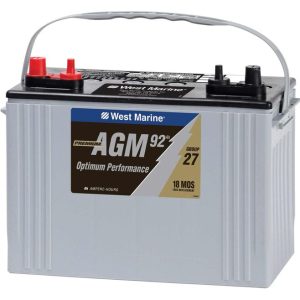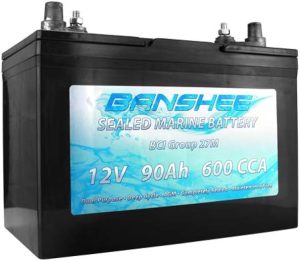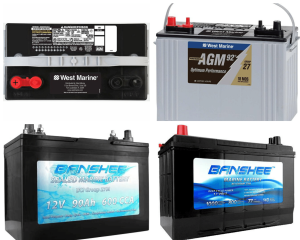Discover the advantages, charging tips, and longevity of Group 27 Agm Dual Purpose Marine Battery. Choose the right Group 27 AGM battery for your marine application.When it comes to choosing the right battery for your marine application, the Group 27 AGM dual-purpose marine battery is a popular and reliable option. In this blog post, we will delve into the different aspects of this versatile battery, from understanding its features and advantages to providing tips for proper charging and maintenance.
First, we will explore what sets the AGM dual-purpose marine battery apart from other types of marine batteries and how it can meet the demands of both starting and deep-cycle applications. Next, we will discuss the specific advantages of opting for a Group 27 AGM battery, such as its maintenance-free design and resistance to vibration and shock.
We will also provide insights into how to properly charge and maintain an AGM battery to ensure optimal performance and longevity. Additionally, we will offer guidance on how to choose the right AGM battery for your marine needs, taking into account factors such as size, capacity, and technology.
Lastly, we will highlight the longevity and overall performance of the Group 27 AGM battery, helping you make an informed decision for your marine power needs.

Understanding the AGM Dual-Purpose Marine Battery
AGM Dual-Purpose Marine Battery refers to Absorbed Glass Mat batteries which are designed to be used in marine applications for both starting and deep cycling. These batteries are constructed with glass mat separators and are valve-regulated, making them spill-proof and maintenance-free. The AGM design allows for a high-performance power source that is resistant to vibration and shock, making them ideal for marine environments.
One of the main advantages of the AGM dual-purpose marine battery is its versatility. It can provide high starting power to crank the engine of the boat, as well as deep cycling power to run onboard electronics and accessories. This dual-purpose functionality makes it a popular choice among boat owners who need a reliable and efficient power source for their marine activities.
When choosing an AGM dual-purpose marine battery, it’s important to consider the size and capacity that will best suit the requirements of the boat and its electrical loads. Group 27 AGM batteries are a common option for medium-sized boats, offering a balance of power and compact size. It’s essential to ensure that the chosen battery meets the specific power demands of the marine application.

Advantages of Group 27 AGM Battery
Advantages of Group 27 AGM Battery
AGM (Absorbent Glass Mat) batteries have become popular choices for marine applications due to their numerous advantages. Group 27 AGM batteries, in particular, offer several benefits that make them an excellent choice for boat owners.
One of the key advantages of a Group 27 AGM battery is its durability. These batteries are built to withstand harsh marine environments, making them highly resistant to vibrations and shocks. This means that they are less likely to suffer damage during rough sea conditions, allowing boat owners to rely on their battery to power their boat consistently.
In addition to their durability, Group 27 AGM batteries also have a longer lifespan compared to traditional lead-acid batteries. This means that boat owners can enjoy a reliable power source for a longer period of time without having to constantly replace their battery. This longevity not only saves money in the long run but also ensures that the battery can be depended on when out at sea.
| Advantages of Group 27 AGM Battery |
|---|
| 1. Durability in harsh marine conditions |
| 2. Longer lifespan compared to traditional lead-acid batteries |
Charging and Maintenance Tips for AGM Battery
When it comes to maintaining an AGM battery, there are a few key things to keep in mind to ensure longevity and optimal performance. One important aspect of AGM battery maintenance is charging. It’s essential to use a compatible charger specifically designed for AGM batteries. Avoid using a charger with a high voltage output, as this can damage the battery. It’s recommended to use a charger with a maximum voltage of 14.8-15 volts for AGM batteries. Additionally, it’s important to monitor the charging process and disconnect the charger once the battery is fully charged to prevent overcharging.
Another crucial aspect of AGM battery maintenance is regular inspection and cleaning. Over time, dirt, debris, and corrosion can accumulate on the battery terminals, which can hinder the battery’s performance. Routinely inspect the battery terminals for any signs of corrosion or buildup, and clean them using a solution of baking soda and water. Ensure that the terminals are completely dry before reconnecting them to the battery to prevent any damage.
Proper storage is also key to maintaining the health of an AGM battery. Store the battery in a cool, dry place away from direct sunlight and extreme temperatures. Extreme heat can cause the battery to degrade more quickly, while extreme cold can affect its performance. When storing the battery, it’s important to keep it charged to prevent sulfation, which can occur when the battery is left in a discharged state for an extended period.

Choosing the Right AGM Battery for Your Marine Application
When it comes to finding the right AGM battery for your marine application, there are several important factors to consider. AGM, or Absorbent Glass Mat, batteries are designed to provide reliable power for marine vessels, but not all AGM batteries are created equal. To ensure that you choose the right AGM battery for your specific needs, it’s important to consider factors such as size, capacity, and durability.
First and foremost, it’s essential to consider the group size of the AGM battery. Group 27 AGM batteries are a popular choice for marine applications due to their versatility and compatibility with a wide range of boats. However, it’s important to ensure that the physical dimensions of the battery will fit within the confines of your boat’s battery compartment. Additionally, considering the capacity of the battery is crucial. A higher capacity AGM battery will be able to provide more power for a longer duration, which is important for marine applications where reliability is key.
Another important factor to consider when choosing the right AGM battery for your marine application is durability. Marine environments can be harsh, with exposure to moisture, vibration, and temperature fluctuations. Therefore, it’s important to select an AGM battery that is specifically designed to withstand these conditions. Look for features such as vibration resistance, sealed construction, and maintenance-free operation to ensure that your AGM battery will provide reliable power for years to come.
Longevity and Performance of Group 27 AGM Battery
When it comes to marine batteries, longevity and performance are two crucial factors to consider. The Group 27 AGM battery is a popular choice for marine applications due to its exceptional durability and reliable performance. These batteries are designed to withstand the rigors of marine environments, providing consistent power for extended periods of time.
One of the key advantages of AGM batteries is their impressive lifespan. With proper maintenance and care, a Group 27 AGM battery can last for years, delivering consistent performance throughout its lifespan. This longevity makes it a cost-effective and reliable choice for marine enthusiasts who require a dependable power source for their watercraft.
Additionally, the performance of Group 27 AGM batteries is unmatched. These batteries are engineered to deliver high cranking power and deep cycling capabilities, making them ideal for starting and powering marine engines, as well as providing a steady source of power for onboard electronics and accessories. Whether you’re out on the water for a day of fishing or embarking on a long-distance voyage, a Group 27 AGM battery will provide the power you need to keep your vessel running smoothly.
| Advantages of Group 27 AGM Battery |
|---|
| Exceptional durability and reliable performance |
| Impressive lifespan with proper maintenance |
| High cranking power and deep cycling capabilities |
Frequently Asked Questions
What is the purpose of a dual purpose marine battery?
A dual purpose marine battery is designed to provide starting power for boat engines as well as deep-cycle power for onboard electronics and accessories.
What are the advantages of using a group 27 AGM dual purpose marine battery?
AGM (Absorbent Glass Mat) batteries are spill-proof, maintenance-free, and have a longer lifespan compared to traditional flooded batteries. They also provide excellent performance in high-demand applications and can be discharged more deeply without damaging the battery.
How long can a group 27 AGM dual purpose marine battery last?
The lifespan of a group 27 AGM dual purpose marine battery can vary depending on usage, maintenance, and charging practices, but it can typically last between 4 to 6 years.
Can a dual purpose marine battery be used for both starting and deep-cycle applications at the same time?
Yes, that is the main advantage of a dual purpose marine battery. It can efficiently handle both starting and deep-cycle power needs simultaneously.
What are some important factors to consider when choosing a group 27 AGM dual purpose marine battery?
Some important factors to consider include the battery’s capacity, reserve capacity, cold cranking amps (CCA), maintenance requirements, warranty, and compatibility with your boat’s electrical system.
How should a group 27 AGM dual purpose marine battery be maintained?
AGM batteries require little maintenance, but regular inspections for corrosion, proper charging, and keeping the terminals clean are important. It’s also essential to follow the manufacturer’s guidelines for charging and storage.
Are there any specific safety precautions to keep in mind when using a group 27 AGM dual purpose marine battery?
Yes, it’s important to always follow proper handling and installation procedures to avoid short circuits, sparks, or accidental spills. Additionally, avoid overcharging or undercharging the battery, and always use personal protective equipment when handling batteries.
